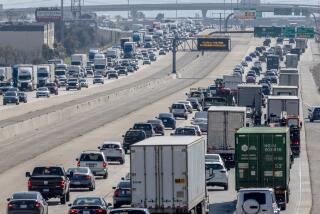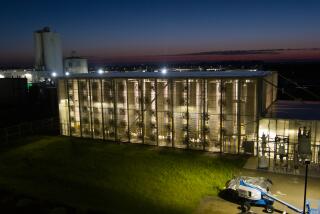China seeks to fight smog by brainstorm: All ideas welcome
Reporting from Beijing — The city of Wuhan is considering building skyscrapers coated with a high-tech substance that can “eat” air pollutants. An artist is offering to suck particulates out of Beijing’s dirty skies using a giant vacuum-cleaner-type device and sell jewelry made with the collected contaminants. One researcher is suggesting an “urban wind passage” in the Chinese capital, regulating the height and density of buildings so that smog has a dispersal channel.
Not a week seems to pass here without a news report on the latest whiz-bang proposal to help solve the country’s critical air pollution problem. Other recent ideas include sending drones aloft to freeze particulates and drop them to Earth, installing giant shower heads on top of buildings to literally wash the smog out of the air, or digging a 100-mile canal from Beijing to the sea to create a fresh-air corridor as water flows to the capital.
Such brainstorms may sound like sheer folly to Americans today. But back in the 1950s, when Southern California was choking on its own haze and Los Angeles was starting to get serious about attacking air pollution, city officials were similarly swamped with silver-bullet schemes aimed at slicing through the smog.
Among the long-forgotten thoughts: boring holes through the San Gabriel Mountains to vent the smog, erecting networks of giant fans on top of buildings or foothills, deploying a fleet of 1,000 helicopters to puncture the inversion layer with their spinning blades.
“Everybody Has a Smog Remedy,” read one L.A. Times headline from November 1953. The proposals got so wacky that then-California Gov. Goodwin Knight was moved to ridicule them as the delusions of “a whole army of Rube Goldbergs.”
“We’re seeing the exact same thing in China that we saw in L.A. — crazy ideas coming out of the woodwork,” says Chip Jacobs, coauthor of “Smogtown: The Lung-Burning History of Pollution in Los Angeles.” “It’s like people all have to go through the same stages of grief — numbness, then anger, bargaining, depression and acceptance.”
In China, the brainstorms have inspired a mixture of delight and derision. Some simply roll their eyes, dismissing such notions as proof that China is not yet serious about tackling its dirty skies. Others contend that the flood of ideas proves that after years of ignoring the problem, or denying its scope, China is finally willing to try anything — and everything — to come to grips.
“It’s easy to just blame the government,” says Daan Roosegaarde, a Dutch artist who spends several months a year in China and who came up with the vacuum cleaner idea. “Sometimes standard science throws away an idea too fast because it’s too radical or won’t be allowed. But here we are in this mess, so what are we going to do? Are we going to wait?”
While some smog solutions might best be described as pie-in-the-sky, others are DIY.
Tinkerers such as Thomas Talhelm, for example, have come up with homemade air purifiers designed to improve indoor air quality.
Talhelm isn’t an engineer by trade — he’s a PhD student in cultural psychology from the University of Virginia whose area of focus is China. But last year, mystified about why air purifiers on the commercial market cost so much, he designed one of his own using a fan, a strap and a HEPA filter he bought online.
After he tested his invention with a particle counter and blogged about the results, friends and acquaintances started bugging him for parts. So he launched a business called SmartAir, selling his kits (starting at $33, compared with commercial purifiers costing thousands of dollars) and running workshops in cities around China teaching people how to build their own. To date, the company has sold close to 7,000 kits and has commissioned U.S.-based product designers to create an original SmartAir purifier system, said employee Gus Tate.
“Awareness is definitely up, and a lot of people are trying to capitalize on it,” said Tate, noting that SmartAir had spawned several copycats. “We sort of became a business not by design but by default.”
Matt Hope went even more MacGyver. Using an Ikea wastebasket, a fighter-pilot mask, a motorcycle helmet, a small generator and other odds and ends, the Beijing-based British artist designed an air-purifying bicycle that he says delivers fresh air to the rider while peddling through Beijing’s smoggy streets. So far, it’s a one-off vehicle.
Other ideas include a dress with sensors to let you know whether you’re sitting pretty in dirty air, and a Filterette — which looks like a cigarette, only one puffs on it to inhale (supposedly cleaner) air, kind of like a smog snorkel (price per 8-pack, $9.95).
“You no longer need to walk around looking like … someone with an infectious disease or a weird alien when trying to protect yourself from particulate pollutants with a hot and uncomfortable face mask,” reads the promotional material.
Beyond gadgets, there are straight-up gimmicks. Chinese entrepreneur Chen Guangbiao last year introduced “canned air” — freshly tinned breatheables in varieties including “pristine Tibet” and “post-industrial Taiwan.”
Chen’s effort, intended to draw attention to China’s pollution crisis and to attract tourist dollars, was reminiscent of 1950s L.A., where souvenir shops went the opposite route — peddling “canned smog.” One label advised users to administer the contents as a mood depressant: open and inhale deeply “when suffering from an overabundance of happiness.”
With a multitude of quirky ideas swirling about, one can lose sight of the fact that thousands of Chinese scientists and technicians are slogging away at unsexy but serious attempts to understand and tackle the country’s environmental challenges.
Starlight, an environmental firm based in Hebei province, recently unveiled a pollution-fighting mobile “fog cannon” designed to dampen the air and control particulate matter at coal depots and other industrial sites. Such technology is recognized as effective by the U.S. Environmental Protection Agency. Shi Hongli, Starlight’s general manager, said that the raft of “non-professional efforts out there can make it frustrating for a serious company like us.”
Reducing pollution, Shi said, requires painstaking efforts to devise solutions, manufacture technology, win government approval and persuade regulators and businesses to buy, install and use the equipment at hundreds of thousands of emissions sites.
Government assistance can make a big difference. In the case of Starlight, it has provided about a third of the funds to develop the fog cannon. “The government is very focused on pollution these days,” said Shi. “They’re making an unprecedented effort to lay out time frames and set targets.”
Shi has been featured on state-run media, including China Central Television, resulting in new business.
“Before, we would have to seek out clients and promote our products,” he said. “Now, they’re coming to us and asking us about what we have.”
The Chinese government has also stepped up investment in environmental research, targeting $1.6 billion this year for air pollution studies. It is also devoting serious time and money to artificial-rain efforts, an idea that officials in California ruled out as impractical.
This year, Beijing’s Meteorological Bureau said it would spend $3.2 million on weather modification efforts aimed at smog reduction; according to the state-run China Daily newspaper, it was the first time weather modification aimed at air pollution was listed as a line item in the budget.
The funds, the bureau said, would be used for experiments and to buy equipment. By 2015, local weather authorities across the country are expected to be able to use weather modification methods to improve air quality, according to the China Meteorological Administration.
“I didn’t realize quite how serious they were, but China has large efforts going into weather modification, what we would call storm-cloud seeding. They actually believe in that a lot more than we do here,” says Eugene Y. Leong, an air pollution expert from California who in recent years has been teaching at Peking University in Beijing.
“One of the things we’ve learned is: Dilution is not the solution to pollution,” Leong said. “To me, a lot of the wacko ideas are running away from the fundamental problem. When all is said and done, if you want to solve the problem, you’ve got to reduce the emissions.”
Follow me on Twitter: @JulieMakLAT
Tommy Yang in The Times’ Beijing bureau contributed to this report.
More to Read
Sign up for Essential California
The most important California stories and recommendations in your inbox every morning.
You may occasionally receive promotional content from the Los Angeles Times.











